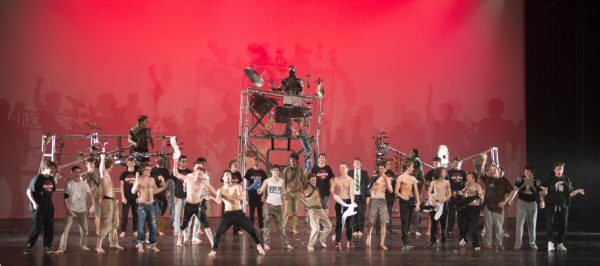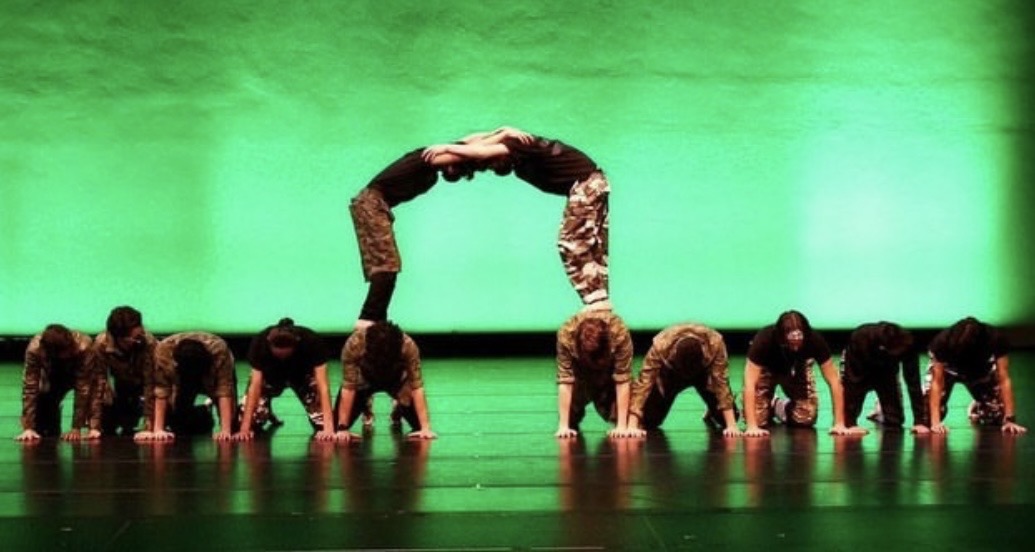If you’ve been at New Trier High School long enough, you’ve seen the iconic group, Menz Dance, perform wild routines, such as the trampoline dance of late 2022, or the intense sword-fighting battle scene of 2023. This is just one course within New Trier’s Dance Division, founded in the 1960s by Toby Nicholson, to provide students a way to come together and express themselves through the art of dance. This school year, the beloved Menz Dance program, featuring male-identifying dancers who create and perform energetic, innovative, and unique routines, was discontinued. However, this is not the first time this has happened.
“I was told that the numbers were going down, and in my mind, I thought they were going to tell me around 15,” Stephen Blood, a second-year Dance Division teacher and last year’s Menz Dance teacher, says. “That was kind of true, but it was split over two semesters, so at most there were about 8 or 9 students in the class, which is very small. It was a lot less than I was expecting, and the demographic of the class had changed a lot.”
With decreasing numbers in the past few years, the overarching goal of the discontinued program is simple: bring it back. While Menz Dance no longer runs, it has proven over and over that because of its great community and close-knit environment, it can return.
Christopher Rutt, who served as Dance Division coordinator from 2000 to 2021, brought back Menz Dance in 2002 after “Boys’ Dance” had previously stopped running in 1996 when Nicholson retired. Although it took effort, he and Matt Ottaviano, the assistant principal at the time, agreed that there was a need for a boys’ dance class. Ottaviano was willing to let the low enrollment numbers slide, believing that the program would provide good opportunities for students.
“It had been gone for so long that if it was going to be resurrected, it had to be given time to prove itself,” Rutt says. “It took a couple of years, but my numbers kept growing consistently after that and at one point, I actually had 75 boys enrolled in three sections of Menz Dance for one year.”

Although Blood only taught the class last year, his love for the program started back in 2009 through 2013 when he was a student of Rutt’s at
New Trier. He says he has stayed friends with many of his former classmates he met in Menz Dance, still valuing the relationships that formed in the studio.
“As a student, I think my favorite part was how genuine everyone was,” Blood says. “It was just a place where you could find yourself. Everyone in there really wanted you to find your thing, and that wasn’t always dance related. Whenever a guy had a new hobby they would come in that room and they would share it and we would be stoked that that person found something they thought was really cool.”
The family-like environment and quick bonding between the boys in the class has always nurtured a strong sense of creativity, encouraging the students to try new things. Under Blood’s leadership, trying to create the same welcoming space he once experienced as a student, the dancers quickly related over in-class activities, forming solid friendships.
“It was pretty close-knit,” junior Alec Kherson, a previous member of Blood’s Menz Dance, says. “A lot of inside jokes and a lot of vibing. There was a lot of chaos, too, but good chaos.”
Many of the students in the program had never danced before, but the warm, inclusive atmosphere prompted them to put themselves out there, despite being new to the art form.While most dance classes at New Trier are level-based, recommending students for level one (beginner) through level four (advanced), Menz Dance welcomed dancers of all abilities to join. Unlike Dance Lab, a level four credit, choreography-based class with invitational enrollment, the Menz Dance program also followed a choreography-based curriculum while allowing less experienced dancers to participate.
“They were all new to modern dance,” Rutt says. “I don’t know anybody that really came in with skills already. It was just a new experience, and I wanted them to see all the fullness that contemporary dance has.”

For many, the program offered new opportunities to express themselves while taking a break from the hectic school schedule.
“I think it’s important because for a lot of people, dance is their creative outlet or their physical outlet,” Kherson says. “It’s good to have an outlet in school as opposed to having it only outside of school.”
Another important aspect of the class remains that students’ voices are heard, and their wants and needs are incorporated into the curriculum. Rutt says that the program was one of the most democratic dance environments he had ever been in, with the students voicing their opinions as equals and helping each other out, regardless of their past dance experience.
“You’re given the ability and the rights, the command to fail—all those things,” Rutt says. “It’s not me trying to place my vice on top of theirs. Yeah, I would teach them some movement vocabulary. I taught them stretches. I taught them how to think rhythmically, but ultimately, when it comes down to it, I want to see what they can do from their own perspective.”
The class allowed students to come up with their own choreography, forming dances, and setting pieces for the class to perform.
“I was the one to choreograph the big Dance Day dance [last year], and everybody kind of had a part in the process,” Kherson says. “If we had a bigger class, you’d have a lot more opportunities to choreograph.”
A highlight of the Menz Dance program was Dance Day at both the Northfield and Winnetka Campuses. Their performance was not only an event looked forward to by the dancers, but by observers and other students as well.
“[When] showcasing their work to Dance Day, they were really considered rock stars by their peers,” Rutt says. “There were times when we had a Menz concert or dance state performance where I couldn’t believe the audience’s reaction. It literally took down the house. It was so loud.”
Many hope the program, although discontinued for now, will return with increased enrollment in the future. Blood, Rutt, and Kherson encourage male-identifying students to go down to the studio and try a dance class, acknowledging that it’s intimidating, but convinced the outcome will be more than worth it.
“Everyone starts one day,” Kherson says. “It really takes time to get into it, but as long as you’re open to it, why are you nervous? Just get started…You’ll get more coordinated, which is nice.”
For the class to run again, the Dance Division encourages students who are interested to voice their opinions. The program is completely student-based, and the division has shown that it will respond to the interests of the students.
“There’s nothing like Menz Dance anywhere else in the country,” Rutt, who recently attended the National Dance Educators Organization conference from Sept. 29 to Oct. 1, says. “No other public high school has had a Menz Dance program or has a program that’s composed of all male-identifying students. It just doesn’t exist.”
While Menz Dance offered such a unique and original curriculum, unlike any other high school program, it had become a well-known, cherished class within the New Trier community.
“[Parents] would come into my parent-teacher conferences sometimes with tears in their eyes, and they’d talk about how their son has grown discipline, confidence, ability, and the ability to touch his toes now,” Rutt says. “If students really feel that there’s a need and they want to do this, I think the administration would listen. I think they could bring it back.”









































Ms. Kritek
Oct 18, 2024 at 1:07 pm
Margy,
This article is fantastic. As the Dance Division Coordinator, I thank you- wholeheartedly! I hope this helps encourage students to register! I appreciate you.
Ms. Kritek
Connie yonan
Oct 18, 2024 at 11:28 am
This is fabulous. I hope it will return!! Bravo!!